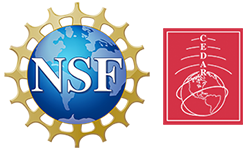2025 Workshop: Ionospheric Scintillation and Plasma Density Irregularities
This session will focus on ionospheric scintillation in the presence of plasma density structures. Such plasma structuring is often enhanced during geomagnetically disturbed times (e.g., geomagnetic storms and auroral substorms), and causes increased scintillation compared to quiet times. Plasma density gradients set up by energetic particle precipitations, often from magnetotail activity, leads to both refractive and diffractive effects on radio waves propagating through the ionosphere from a GNSS satellite to a ground-based receiver. Here we aim to examine ionospheric plasma structure and stability in relation to GNSS phase and amplitude scintillation. Presentations on the development of plasma irregularities related to scintillation and the specific processes of diffractive and refractive scintillation are encouraged.
Join ZoomGov Meeting
https://sri.zoomgov.com/j/1609348305?pwd=VgNbPCdlBT9XI9ZAwGELtsZVVDNLva…
Meeting ID: 160 934 8305
Password: 519985
One tap mobile
+16692545252,,1609348305# US (San Jose)
+16469641167,,1609348305# US (US Spanish Line)
Dial by your location
+1 669 254 5252 US (San Jose)
+1 646 964 1167 US (US Spanish Line)
+1 646 828 7666 US (New York)
+1 415 449 4000 US (US Spanish Line)
+1 551 285 1373 US (New Jersey)
+1 669 216 1590 US (San Jose)
833 568 8864 US Toll-free
Meeting ID: 160 934 8305
Find your local number: https://sri.zoomgov.com/u/aBl4YL9jm
Join by SIP
1609348305@sip.zoomgov.com
Join by H.323
161.199.138.10 (US West)
161.199.136.10 (US East)
Meeting ID: 160 934 8305
Password: 519985
(13:30-13:35) Introductory Remarks
(13:35-13:55) Waqar Younas, “Spatio‐Temporal Evolution of Mid‐Latitude GPS Scintillation and Position Errors During the May 2024 Solar Storm”
(13:55-14:15) Alex Green, “Finite-Difference Time Domain Simulations of Scintillation”
(14:15-14:35) Matthew Young, “Large-Scale Wave-Driven Farley-BunemanIrregularities in 3D”
(14:35-14:55) Braeden Peterson, “Correlation Analysis of Ionospheric Drivers on Scintillations”
(14:55-15:07) Mahith Madhanakumar, “On the Onset and Fading of GNSS Scintillation Intensity during Quiet Geomagnetic Conditions”
(15:07-15:19) Eun-Hwa Kim, “High-Frequency Wave Propagation in the Equatorial Plasma Bubbles: Ray Tracing and Full-Wave Simulations”
(15:19-15:30) Joanna Halfhill, “Ionospheric Scintillation over West Point during the May 10 Storm”
Given the well-attended sessions last time, insufficient time to address the proposed topics and community interest in the topic, we are resubmitting a continuation of our previous proposal with slight modifications.
Phase and amplitude scintillation of GNSS radio waves traveling from satellites to receivers through ionospheric plasma leads to reduced ability to obtain accurate position, navigation and timing (PNT), which impacts a variety of societally important operational systems. It is clear that plasma density enhancements during geomagnetically active times contribute to this problem, modifying both refractive and diffractive effects. These plasma density structures undergo spatio-temporal evolution as the scintillation is occurring. Many questions remain unanswered about the distinct effects on GNSS scintillation induced by a wide variety discrete auroral structures. Phase and amplitude scintillation both occur in these regions, but their similarities and differences in altitude, magnetic latitude and magnetic longitude are still widely debated. In addition, with regard to diffractive scintillation, it is unclear what plasma instability magnifies the density irregularities to cause appreciable effects. Finally, several indices (ROTI, sigma_phi, S_4, IFLC, etc.) are often applied to characterize scintillation effects, and the indices do not always agree, and also vary in relation to optical Fresnel radius and frequency. In short, ionospheric scintillation is a unified topic of study with many questions in need of resolution through focused community-wide collaborative efforts. Its practical impacts on space weather and operations demand a deeper understanding of the underlying physical phenomena.
A wide variety of observational and instrumentation strategies apply to this topic as well, including scatter radars, GPS satellites and receivers, ground magnetometers and all-sky imagery. Data assimilation techniques and total electron content maps, both data-based and model based, are often used in order to study local and global plasma density structuring in response to solar wind driving of the magnetosphere-ionosphere system. These approaches, when integrated, will allow further clarification of the general geospace system and its dynamical evolution.
